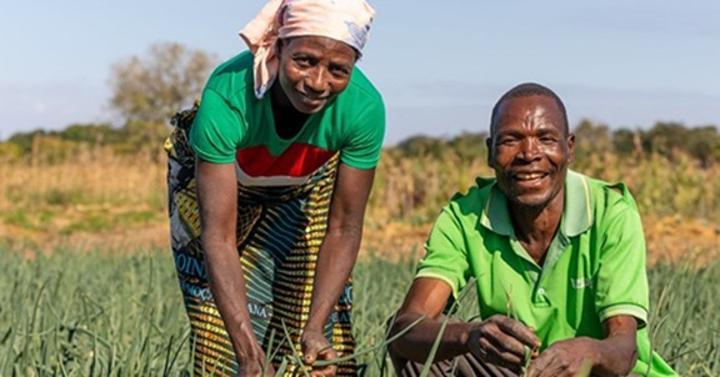Africa-Press – Mozambique. The sun beats down on the cracked soil of Maringué. Here in central Mozambique, the land still bears the scars of a harsh season. The drought triggered by the El Niño phenomenon devastated harvests and livelihoods for thousands of farming families. But where many see only dust and loss, others are beginning to plant seeds of recovery.
Evaristo Chigo and Fazminha Biassone know this reality all too well. Parents to six children — the eldest aged 23 and the youngest just 8 — they spent over a year watching their hard work dry up along with the rains that never came. “Last year, we got nothing. The land gave us nothing. Pests destroyed what little was left,” Evaristo recalls, his voice calm but resolute.
The family now cultivates one hectare of maize, another of millet and beans, and has started a 0.25-hectare vegetable garden with onions, cabbage, tomatoes and kale. This level of crop diversity is new to them. “We used to grow just the basics: maize, millet and beans. Now we can even think about selling something at the market. We’re no longer relying on the miracle of rainfall alone,” adds Fazminha, with a quiet mix of pride and caution.
Their story is far from unique. It’s part of a broader effort to restore dignity, self-reliance and resilience across communities hit hardest by the climate emergency. Funded by the UN Central Emergency Response Fund (CERF) and led by the Government of Mozambique with technical support from the Food and Agriculture Organization of the United Nations (FAO), the project “Improving food security for households affected by El Niño-induced drought” is reaching over 225 000 people across Manica and Sofala provinces.
One of the project’s cornerstones is collective action. In Guerani Di Pangana Nzero, the local Farmer Field School (FFS) was reactivated after years of inactivity. Though originally established under a different FAO initiative, the group — made up of 40 members, mostly women — had continued meeting on their own, sharing knowledge and supporting one another. “When FAO arrived with inputs and training, we were already organized. We just needed a push,” says one of the members.
Through an e-voucher system, families receive tailored agricultural packages for each season. In the main crop season, Evaristo and Fazminha used his electronic voucher to purchase 5 kg of maize and 5 kg of millet seeds, 3 kg of beans, and farming tools. In the winter season, they purchased vegetable seeds: beans, onions, tomatoes, cabbage and kale. “Now we farm with a plan. We know when to plant, what to plant and how. And if something goes wrong, we know who to ask. Before, we were working blindly,” explains Evaristo.But the approach is not just technical. The FFS group makes decisions democratically: they vote, debate and prioritize inclusion. Every Thursday from 6 to 10 a.m., the group works together on the FFS plot. After that, each member returns to their own machamba (field). “What we learn here, we take home,” Fazminha notes.
Evaristo and Fazminha in their home vegetable garden, holding the electronic voucher card. [Photo: FAO/María Legaristi Royo]One of the most important innovations introduced by the project is drip irrigation, which allows crops to survive even during dry spells. Ten households in Maringué have already been selected for installation, and technicians will be trained in the coming weeks to begin setup.
The seeds provided are short-cycle and drought-resistant, meaning they can yield a harvest even when rainfall is limited or inconsistent. In Mozambique — where 70 percent of the population depends on subsistence agriculture — this can mean the difference between having food or going hungry.
The Chigo-Biassone family has also rehabilitated an old water system shared by a relative, built a small grain storage facility that holds up their 15 bags of 50 kg of maize each, and now raise 40 ducks and 50 chickens for family consumption. “Little by little, we’re closing the cycle,” Fazminha says. “We plant, harvest, store, eat and then plant again.”
View of their house with the maize storage facility / [Photo: FAO/María Legaristi Royo]Evaristo and Fazminha standing next to their maize storage. [Photo: FAO/María Legaristi Royo] What this project sets in motion goes far beyond improved agricultural practices. It builds networks of knowledge, resources and mutual trust, turning vulnerable communities into drivers of their own recovery. It promotes soil conservation, the use of natural inputs, local seed multiplication and sustainable farming methods — not just as a response to the emergency, but as a pathway to a more resilient future.
Because what’s at stake isn’t just this season’s harvest — it’s the ability to withstand the next drought, the next pest outbreak, the next crisis.
In Evaristo’s words: “The project didn’t give us charity. It gave us tools to start again.”
For More News And Analysis About Mozambique Follow Africa-Press






